Ajaccio Main Sights
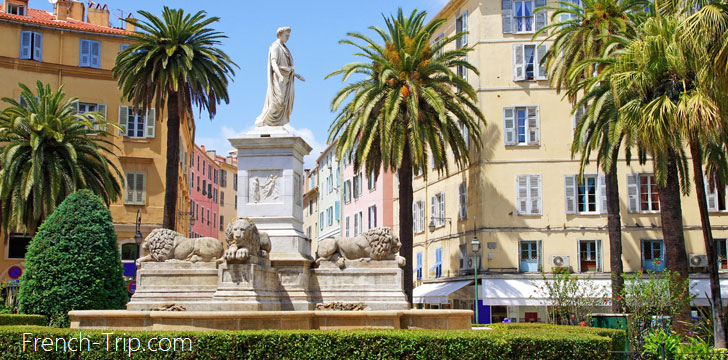
Ajaccio stands out among Corsican cities for its rich historical ties, especially as the birthplace of Napoleon Bonaparte, offering a deep dive into his legacy with landmarks like the Maison Bonaparte and Napoleon-themed statues throughout the city.
Unlike smaller villages, Ajaccio combines historical intrigue with the conveniences of a modern city, including excellent restaurants, shops, and museums like the Fesch Museum. Its coastal location provides stunning Mediterranean scenery, with easy access to beaches and excursions to the Îles Sanguinaires. The blend of culture, history, and natural beauty makes Ajaccio a unique destination compared to other Corsican cities and villages.
Ajaccio Main Sights
All the sights of Ajaccio can be seen in literally 1 hour. If you do not count the Greek chapel, which is located off to the side, then a walk around Ajaccio in the specified sequence will take 34 minutes and 2.6 km. If you include the Greek chapel, it will be 54 minutes and 4.2 km.
Cathedral
The Cathedral of the Assumption of Our Lady (Cathédrale Notre-Dame de l’Assomption de Ajaccio) was built in 1593 and is known as the place where the young Napoleon Bonaparte was baptized. Constructed in the Baroque-Mannerist style, it belongs to the Roman Catholic Church and is dedicated to the Virgin Mary. The cathedral was designed by Italian architect Giacomo della Porta and completed to replace the earlier Cathedral of Sainte-Croix, which was demolished in 1553 to make room for city fortifications.
It was here that Napoleon Bonaparte was baptized on July 21, 1771. On his deathbed on Saint Helena in 1821, he said:
“If they forbid my corpse, as they forbade my body, if they deny me a small piece of land in which to be buried, I want to be buried with my ancestors in the Cathedral of Ajaccio in Corsica.”
According to legend, on August 15, 1769, Letizia Bonaparte suddenly felt the pains of childbirth in this cathedral. She rushed home to the Buonaparte house, located just a few steps away, and gave birth to Napoleon on a sofa on the first floor before she could reach her bedroom upstairs.
The cathedral was officially listed as a historical monument in 1906.
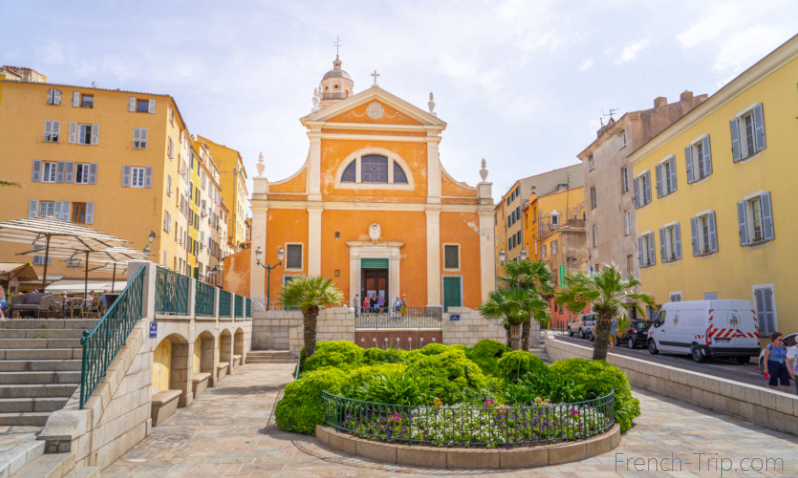
Citadel of Ajaccio
The Citadel of Ajaccio was built on a rocky promontory in 1492 to defend the city. This year is considered the date of the foundation of Ajaccio. At that time, the citadel included a simple castello, a dungeon and a lower chamber. Work to improve the city’s defenses began in 1553. The moats were widened and deepened and connected to the sea after the signing of the Treaty of Cateau-Cambresis in 1559. Then the citadel acquired its current appearance.
- Getting there: buses 1/ 2/ 3/ 4/ 5/ 7/ 9 – stop: Cathédrale
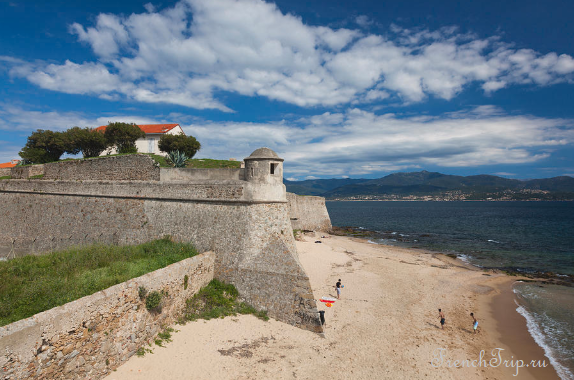
Foch Square and Napoleon Monument
Napoleon is depicted as a Roman consul. The author of the sculpture is Massimiliano Labouré. To the left of Rue Bonaparte, in a niche, is a statue of the Virgin of Mercy (Madonuccia), patroness of Ajaccio, whose feast day is celebrated on March 18.
Until the beginning of the 19th century, Foch Square, then known as Palmiers, was the end of the old town, beyond which the suburbs began (rue Fesch).
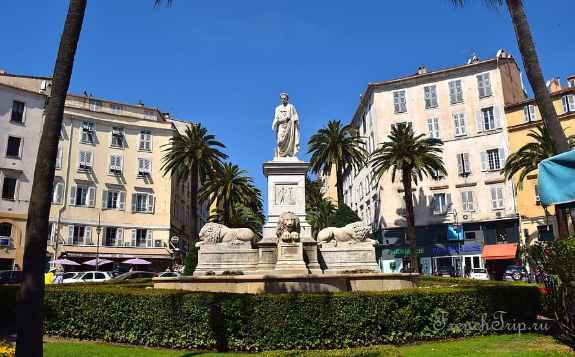
Napoleon Bonaparte’s House (maison Bonaparte)
La maison Bonaparte is the house where Napoleon Bonaparte was born. The house was owned by this family for almost all of this time, from 1682 to 1923.

Napoleon was born in this house on August 15, 1769, and lived here until the age of nine before leaving for school in Autun. At the time, his parents, Carlo and Letizia Bonaparte, occupied the ground floor where the kitchen was located. In 1774, Napoleon’s father added a terrace to extend the house. Over time, the family acquired the second and third floors, which were originally owned by other relatives.
The room where Napoleon was born:
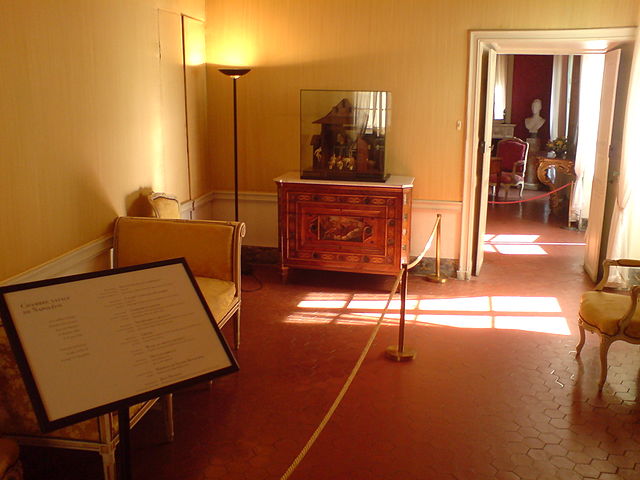
Napoleon Museum
Finally, in 1967, the house became a national museum, currently run by the National Museum of Malmaison and Bois-Pré. The building was expanded in 2004 with the purchase of the neighboring house, providing additional exhibition space dedicated to the Second Empire and temporary exhibitions.
- Read more: Napoleon in Ajaccio
Visiting Napoleon’s House
During the months of July, August and September, due to the high attendance, I strongly recommend arriving before 3:30 pm to be sure to enter the museum. The queue is very long during these months.
- Self-guided tour with audio guides
- People with reduced mobility do not have access to the entire museum. They can visit part of the first floor and the ground floor as well as the temporary exhibition.
- Opening Hours:
- Closed on Mondays
- October 1 – March 31: 10:30 AM to 12:30 PM and 1:00 PM to 4:30 PM
- April 1 – September 30: 10:00 AM to 12:30 PM and 1:15 PM to 5:30 PM
- July 1 – September 30: continuous opening 10 AM – 5:30 PM
- Last entry 30 minutes before closing.
- Ticket prices:
- Adult — €7
- Reduced — €5
- Free — 1st Sunday of the month
- Address: Rue Saint-Charles
- Getting there:
- Bus lines no. 1,2,3,4,5,7 Cathedral stop
- Bus and ferry station 200 m away
- Website

Street decoration with crowns (Cours Napoléon)
Cours Napoléon is a prominent thoroughfare in Ajaccio that pays homage to Napoleon Bonaparte, who was born in the city. Recently renovated, it features beautiful light decorations that enhance its appeal, especially during the evening hours. The lighting design highlights the palm trees lining the promenade and illuminates key monuments, creating a vibrant atmosphere that attracts both locals and tourists. This revitalization is part of a broader effort to enhance the city center’s attractiveness and accessibility, making Cours Napoléon a lively hub for shopping, dining, and cultural experiences. The area is also home to significant landmarks, including the Palais Lantivy (Prefecture) and the Church of Saint-Roch, making it a focal point for exploring Ajaccio’s rich history.
The crowns decorating Ajaccio’s streets are modeled after the emblematic French imperial crown, which features a circular design with an ornate, jeweled appearance. They are prominently displayed on the central street of Ajaccio, known as Cours Napoléon, and various other locations around the city.
These crowns symbolize Napoleon’s enduring legacy and his deep connection to Ajaccio, where he was born and spent his early years. They not only honor his imperial status but also celebrate his contributions to French history. The use of these crowns in street decoration emphasizes Ajaccio’s pride in its historical association with Napoleon and its role as a significant site in his life.
Musee Fesch
The Musée Fesch is a premier art museum renowned for its impressive collection of Italian Renaissance paintings. Established in 1852 by Napoleon’s uncle, Cardinal Joseph Fesch, the museum houses masterpieces by renowned artists such as Botticelli, Titian, and Caravaggio. Its elegant neoclassical building complements the rich artistic heritage contained within its walls. The Musée Fesch not only highlights Corsica’s cultural ties to Italy but also offers a captivating experience for art enthusiasts and history buffs alike.
- Address: 50-52 rue cardinal Fesch Ajaccio 20000
- All areas and services of the museum are accessible to people with reduced mobility (rental wheelchairs and children’s strollers)
- Tickets: Full price: €10 Reduced price: €6
- Opening time:
- From May 1st to October 31st the museum is open: Every day from 9:15 a.m. to 6:00 p.m.
- From November 1st to April 30th the museum is open: Every day from 9:00 a.m. to 5:00 p.m. (except annual closure see below)
- Closed: Christmas; New Year’s Day.
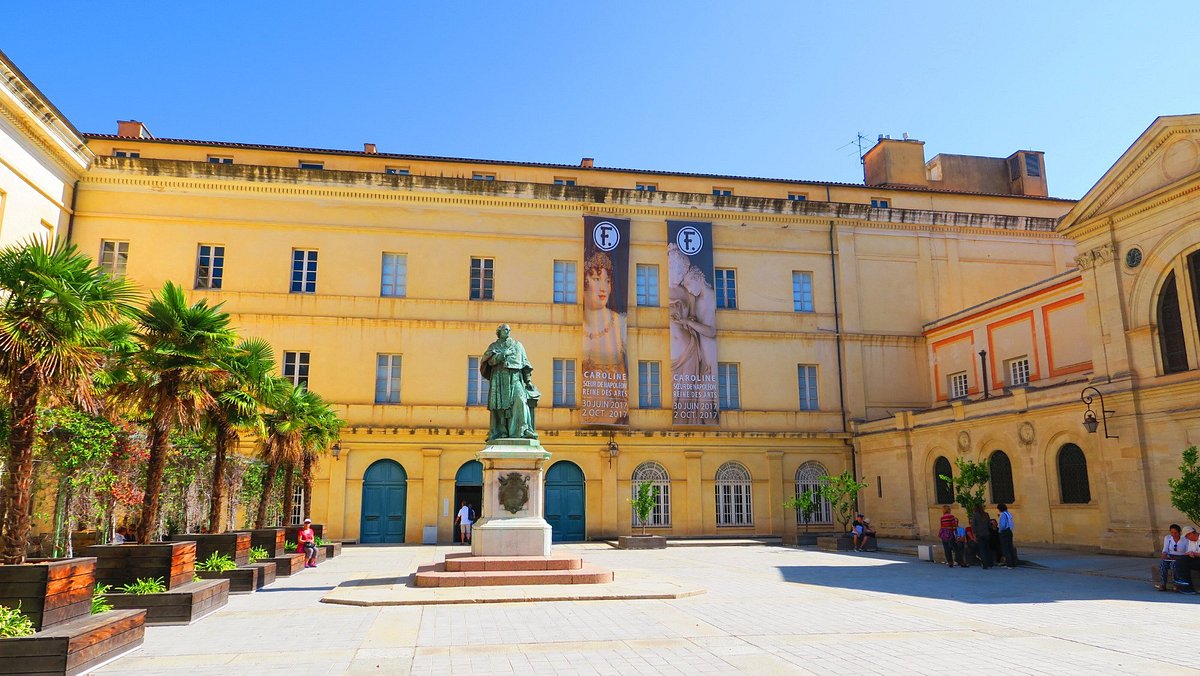
Imperial Chapel and Crypt of the Bonaparte Family
The Imperial Chapel, located in the southern wing of the complex founded by Cardinal Fesch, was constructed between 1827 and 1837. Originally intended to house a school, library, and museum, the chapel was designed to serve as the burial site for prominent members of the imperial family. Although Cardinal Fesch envisioned it as a funerary church dedicated to the Immaculate Conception, his wishes were delayed due to political opposition. The project, initially stalled by the refusal of Joseph Bonaparte and the Prince of Canino’s death, was eventually completed under Napoleon III.
Designed by architects Alexis Paccard and Joseph Cazeneuve in neo-Renaissance style, the chapel features Saint-Florent stone, grisaille paintings by Jérôme Maglioli, and intricate stained glass. It was blessed by Abbot Versini on September 9, 1860.
Chapel is a part of Fesch museum.
- Address: 50 Rue Fesch
- Getting there: buses 1/ 2/ 3/ 4/ 7 – stop: St Roch
- Opening hours: only during the summer season
from May 1st to October 31st, every day from 9:15 a.m. to 6:00 p.m.

Grotte de Napoléon
The Grotte de Napoléon, located on Place d’Austerlitz (also known as Place du Casone), is not an actual cave but rather a natural shelter formed by large granite boulders. According to a legend, the young Napoleon Bonaparte often retreated to this spot to read and contemplate his future. While the “cave” itself is relatively small and unassuming, it has become a significant historical site due to its association with the famous emperor.
In 1938, a monumental ensemble was erected nearby to honor Napoleon. This impressive structure consists of a large stone promontory covered with inscriptions, topped by a small stepped pyramid that serves as a pedestal for a bronze statue of Napoleon. The statue is a replica of the one that once stood atop the Vendôme column in Paris. This memorial, with its grand design and historical significance, has become a popular attraction for visitors interested in Napoleon’s early life and Ajaccio’s rich history.

Église Saint-Roch
Church of Saint Roch. Built in neoclassical style in 1885 under the direction of the architect Bartolomeo Maglioli (born in Ajaccio, 1856 – 1909).
This church features a sober yet elegant facade that invites contemplation. Upon entering, visitors are greeted by a spacious interior adorned with colorful stained glass windows that filter light beautifully, creating a serene atmosphere. The high altar is a focal point, decorated with statues and paintings that enhance the church’s spiritual ambiance. Beyond its role as a tourist attraction, Église Saint-Roch remains an active place of worship, hosting regular religious services that provide moments of meditation for both locals and visitors.
- Open: daily from 10 AM to 6 PM (Monday to Saturday)
Рalais Lantivy – Préfecture de Corse
This palace houses the prefecture of the Corse-du-Sud department. The palace building was constructed between 1826 and 1830 under the direction of the architect Alphonse de Gisors. The palace was named after the prefect of Corsica, Gabriel Lantivy de Kerveno.
The prefecture of Corsica (now a single department) has been located in the building since 1837. The palace has been partially listed as a historical monument of France since January 30, 1990.

Eglise du Sacre Coeur
Church of the Holy Heart. The church received its name on the day of its consecration, July 7, 1929, the feast of the Holy Heart. It was built in 1920 as a tribute to those who died during the First World War. It is distinguished by its neo-Byzantine style. The work on the decoration of the facade was carried out by the master Jacquemuns Robert. The windows of the church were created by Valentin Reyret. The interior is distinguished by simplicity. On the wall are written the names of 351 natives of the city of Ajaccio who died.
- Address: 10 boulevard Sylvestre Marcaggi
- How to get there: buses 2/5 — stop: Marcaggi

Eglise Anglicane
Anglican Church. The church was built in 1869 on the initiative of Miss Campbell, since at that time up to a thousand British people came to the city. Construction was completed in 1878. Polychrome stones from different regions of the island were used for the construction.
- How to get there: bus 7 to the stop Grandval

Greek Chapel
At the end of the 17th century and the beginning of the 18th century, the chapel of Notre-Dame (Our Lady) on Mount Carmel was at the disposal of the Greek colony of Paomia (an old town near Cargese). For this reason, it was given the name “Greek Chapel”, although it is no longer an Orthodox church.
- Access: buses 2/ 5/ C – stop: Chapelle des Grecs

→ Back to Ajaccio travel guide
Archives
Calendar
| M | T | W | T | F | S | S |
|---|---|---|---|---|---|---|
| 1 | 2 | 3 | 4 | 5 | 6 | 7 |
| 8 | 9 | 10 | 11 | 12 | 13 | 14 |
| 15 | 16 | 17 | 18 | 19 | 20 | 21 |
| 22 | 23 | 24 | 25 | 26 | 27 | 28 |
| 29 | 30 | 31 | ||||